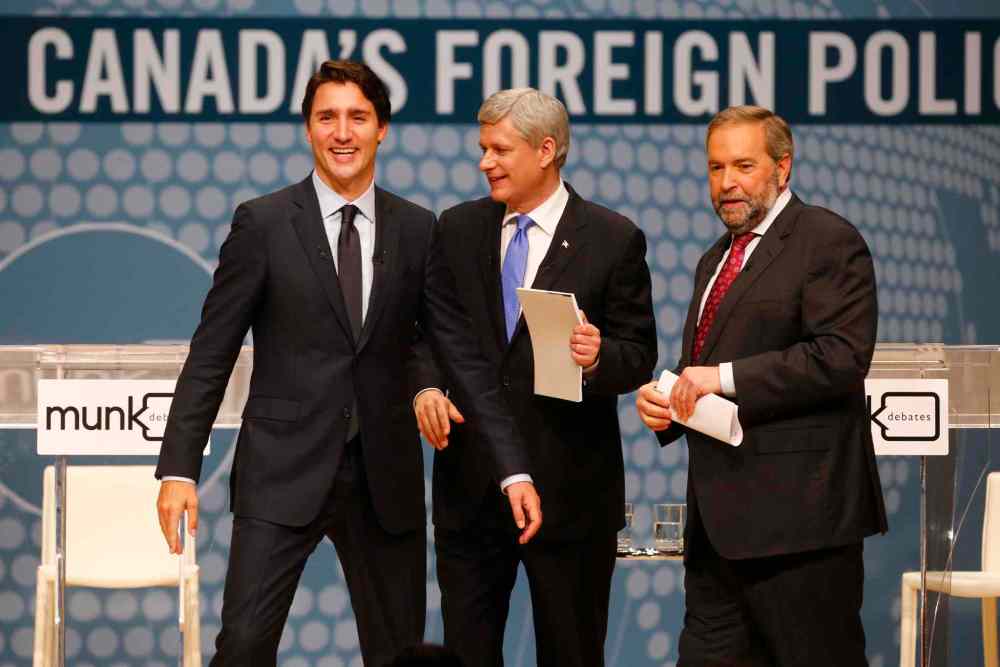Canada’s new normal
Staying 'on point' remains name of never-ending election game
Advertisement
Read this article for free:
or
Already have an account? Log in here »
To continue reading, please subscribe:
Monthly Digital Subscription
$1 per week for 24 weeks*
- Enjoy unlimited reading on winnipegfreepress.com
- Read the E-Edition, our digital replica newspaper
- Access News Break, our award-winning app
- Play interactive puzzles
*Billed as $4.00 plus GST every four weeks. After 24 weeks, price increases to the regular rate of $19.00 plus GST every four weeks. Offer available to new and qualified returning subscribers only. Cancel any time.
Monthly Digital Subscription
$4.75/week*
- Enjoy unlimited reading on winnipegfreepress.com
- Read the E-Edition, our digital replica newspaper
- Access News Break, our award-winning app
- Play interactive puzzles
*Billed as $19 plus GST every four weeks. Cancel any time.
To continue reading, please subscribe:
Add Free Press access to your Brandon Sun subscription for only an additional
$1 for the first 4 weeks*
*Your next subscription payment will increase by $1.00 and you will be charged $16.99 plus GST for four weeks. After four weeks, your payment will increase to $23.99 plus GST every four weeks.
Read unlimited articles for free today:
or
Already have an account? Log in here »
Hey there, time traveller!
This article was published 01/10/2015 (3670 days ago), so information in it may no longer be current.
Election campaigns in Canada have changed significantly from when I first began as a journalist. My first federal election was in 1979, when Joe Clark’s Conservatives edged the Liberals to form a short-lived minority government.
In those days, elections were relatively formulaic: the prime minister walked to the Governor General’s office, dropped the writ and an election was called for 36 days later. During that campaign period, there was generally a small smattering of policy announcements, the big reveal of the policy books (usually around Week 2), the election debates broadcast in English and French on all television networks (Week 3 or so) and then the final push with increased advertising in newspapers and on television.
Well, we’re in the new normal now. Modern election campaigns are nothing like that.

Much of it is a direct result of a transition from a regular campaign period to the permanent campaign. But much of it is also due to the increased “mediatization” of politics — a phenomenon that shapes politicians every waking moment.
Boiling it down to simple terms, mediatization is a process in which politicians move from working on issues of public policy and “doing what’s right” for the constituents to focusing only on the end goal — getting elected. There’s evidence political parties have moved away from public service and the greater good to ensuring the party stays in power, by whatever means possible. As a result, there’s a lot of emphasis on ensuring a politician “stays on point” and the brand is maintained.
It’s why the recent debates we’ve been watching have had the party leaders repeating the same sentences over and over again — a way of repeating a party message in exactly the right way. There’s limited opportunity for a politician to relax and speak off-script and when he or she does, there’s hell to pay.
This environment spurs on the continuation of the permanent campaign, which we’ve seen become entrenched since 2000. Think about it: Canada has had six federal elections in 16 years — three of them resulting in minority governments. In 2015, we may see a fourth minority win. The campaigning has never really stopped.
What this means is the line between party and government is increasingly blurred. We’ve seen this with the Conservatives. The colours of the government web pages used to be red and white — the colours of the Canadian flag (and also the colours of the Liberal party). They’re now blue and grey, the colours of the Tories.
The brand became the Harper government — not the Canadian government — and the Prime Minister’s Office became very powerful, with little chance for MPs to speak for themselves. Instead, the message was tightly controlled.
As a way of sidestepping the media, political parties have made it a point of reaching beyond the traditional to new media platforms such as Twitter, Facebook and YouTube.
The Conservatives were well ahead of the curve on this one. They were brilliant in their adaptation of the new media and their messaging to strategically gain power, using the alternate media to drive their message, both in and out of the election period.
It just takes one supporter to tweet out the video into the Twitter-verse, and an audience is reached that may not be accessible by television, radio or newspapers.
This election campaign, the Conservatives have pushed it even further, turning their back on the traditional broadcast consortium debates that have been the mainstay of political campaigns since the 1970s.
Instead, Tory Leader Stephen Harper would only commit to a series of specific debates organized by the Globe and Mail in conjunction with CPAC and Google. The other leaders quickly followed suit.
It was another way of showing the media who is boss. And for Harper, it’s about protecting the brand and maintaining his base.
It used to be, back in the day, the government would arrange to meet with the editorial board of Canadian newspapers to put forward its perspective in a face-to-face interview.
In the new normal, Harper limits who has access and ensures his candidates do, as well.
Case in point: Harper met with Metro newspapers earlier this week and stated how much the political elite just don’t understand the ordinary Canadian. And yet, his candidates will not engage with the ordinary Canadian in local debates in any way. The running tally of Conservative no-shows is growing.
So we’re at this new normal in which political campaigns aren’t about selling policy ideas or engaging voters. We’re now at a time when it’s about staying on point, repeating the same lines over and over.
The Liberals and the NDP would be fools not to follow in those footsteps. After all, it’s worked tremendously well for the Conservatives. Don’t expect things to improve if there is a change in government.
But there is a downside to all this: likely an even-lower turnout at the polls, less intelligent political engagement and a generally more cynical electorate.
That’s really depressing.
Shannon Sampert is the perspectives and politics editor at the Winnipeg Free Press.
shannon.sampert@freepress.mb.ca Twitter: @paulysigh
History
Updated on Thursday, October 1, 2015 7:32 AM CDT: Replaces photo













